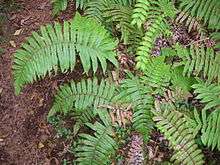Thelypteridaceae
Thelypteridaceae is a family of about 900[2] species of ferns in the order Polypodiales.[3][4][5] In the Pteridophyte Phylogeny Group classification of 2016 (PPG I), it is placed in the suborder Aspleniineae.[3] Alternatively, the family may be submerged in a very broadly defined family Aspleniaceae as the subfamily Thelypteridoideae.[6]
| Marsh fern family | |
|---|---|
 | |
| Cyclosorus cyatheoides | |
| Scientific classification | |
| Kingdom: | Plantae |
| Clade: | Tracheophytes |
| Class: | Polypodiopsida |
| Order: | Polypodiales |
| Suborder: | Aspleniineae |
| Family: | Thelypteridaceae Ching ex Pic.Serm.[1] |
| Genera | |
|
See text. | |
The ferns are terrestrial, with the exception of a few which are lithophytes (grow on rocks).[5] The bulk of the species are tropical, although there are a number of temperate species.[5]
These ferns typically have creeping rhizomes. The fronds are simply pinnate to pinnate-pinnatifid. There is either no frond dimorphism or only mild dimorphism, either open venation or very simple anastomosing. The sori are mostly reniform in shape and have indusia, except for the Phegopteris group.
Classification
At one time, all thelypterioid ferns were included in the genus Dryopteris because of the sorus shape. However, there are a great many differences between the groups, and these plants are now segregated in their own family.[2][3] Genetic evidence shows that the family is clearly monophyletic.[3]
Phylogenetic relationships
The following cladogram for the suborder Aspleniineae (as eupolypods II), based on Lehtonen (2011),[7] and Rothfels & al. (2012),[8] shows a likely phylogenetic relationship between the Thelypteridaceae and the other families of the clade.
| Aspleniineae (eupolypods II) |
| ||||||||||||||||||||||||||||||||||||||||||||||||||||||
Genera
The family can be divided into two major clades, which the Pteridophyte Phylogeny Group classification of 2016 (PPG I) recognizes as two subfamilies, Phegopteridoideae and Thelypteroideae.[3] Their division into genera has been described as "highly controversial and fluctuating".[9] The family includes several complexes of species that are difficult to distinguish, and seem to represent a remarkable evolutionary radiation. Some researchers include the entire family Thelypteridaceae in the genus Thelypteris; others divide the family into as many as 30 genera.[9] An intermediate position is to place the bulk in Thelypteris (which can then be divided into subgenera and sections corresponding to the genera of other authors) but to separate out Phegopteris and Macrothelypteris.[2] Another choice is to divide the family into a half a dozen or so genera.[5]
The Pteridophyte Phylogeny Group classification of 2016 (PPG I) accepts 30 genera:[3]
- Subfamily Phegopteridoideae Salino, A.R.Sm. & T.E.Almeid
- Macrothelypteris (H.Ito) Ching
- Phegopteris (C.Presl) Fée
- Pseudophegopteris Ching – here treated as a synonym of Phegopteris[10][11]
- Subfamily Thelypteridoideae C.F.Reed
- Amauropelta Kunze
- Amblovenatum J.P.Roux
- Ampelopteris Kunze
- Chingia Holttum
- Christella H.Lév.
- Coryphopteris Holttum
- Cyclogramma Tagawa
- Cyclosorus Link
- Glaphyropteridopsis Ching
- Goniopteris C.Presl
- Meniscium Schreb.
- Menisorus Alston
- Mesophlebion Holttum
- Mesopteris Ching
- Metathelypteris (H.Ito) Ching
- Nannothelypteris Holttum
- Oreopteris Holub
- Parathelypteris (H.Ito) Ching
- Plesioneuron (Holttum) Holttum
- Pneumatopteris Nakai
- Pronephrium C.Presl
- Pseudocyclosorus Ching
- Sphaerostephanos J.Sm.
- Stegnogramma Blume
- Steiropteris (C.Chr.) Pic.Serm.
- Thelypteris Schmidel
- Trigonospora Holttum
References
- Thelypteridaceae Ching ex Pic. Serm. Tropicos.org. Missouri Botanical Garden. 24 Jan 2012
- "Thelypteridaceae". Flora of North America.
- PPG I (2016). "A community-derived classification for extant lycophytes and ferns". Journal of Systematics and Evolution. 54 (6): 563–603. doi:10.1111/jse.12229.
- Maarten J. M. Christenhusz, Xian-Chun Zhang & Harald Schneider (2011). "A linear sequence of extant families and genera of lycophytes and ferns" (PDF). Phytotaxa. 19: 7–54.
- Alan R. Smith, Kathleen M. Pryer, Eric Schuettpelz, Petra Korall, Harald Schneider & Paul G. Wolf (2006). "A classification for extant ferns" (PDF). Taxon. 55 (3): 705–731. doi:10.2307/25065646.CS1 maint: multiple names: authors list (link)
- Christenhusz, Maarten J.M. & Chase, Mark W. (2014). "Trends and concepts in fern classification". Annals of Botany. 113 (9): 571–594. doi:10.1093/aob/mct299. PMC 3936591. PMID 24532607.
- Samuli Lehtonen (2011). "Towards Resolving the Complete Fern Tree of Life" (PDF). PLoS ONE. 6 (10): e24851. doi:10.1371/journal.pone.0024851. PMC 3192703. PMID 22022365.
- Carl J. Rothfels; Anders Larsson; Li-Yaung Kuo; Petra Korall; Wen- Liang Chiou; Kathleen M. Pryer (2012). "Overcoming Deep Roots, Fast Rates, and Short Internodes to Resolve the Ancient Rapid Radiation of Eupolypod II Ferns". Systematic Biology. 61 (1): 70. arXiv:cond-mat/0606434. doi:10.1093/sysbio/sys001. PMID 22223449.
- Hassler, Michael & Schmitt, Bernd (January 2020). "Thelypteridaceae". Checklist of Ferns and Lycophytes of the World. 8.20. Retrieved 2020-01-11.
- Hassler, Michael & Schmitt, Bernd (January 2020). "Phegopteris". Checklist of Ferns and Lycophytes of the World. 8.20. Retrieved 2020-01-10.
- "Phegopteris (C.Presl) Fée". Plants of the World Online. Royal Botanic Gardens, Kew. Retrieved 2020-01-10.